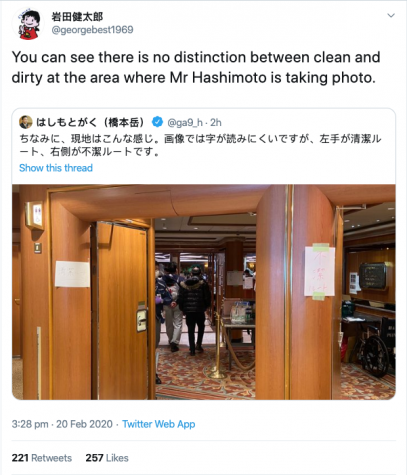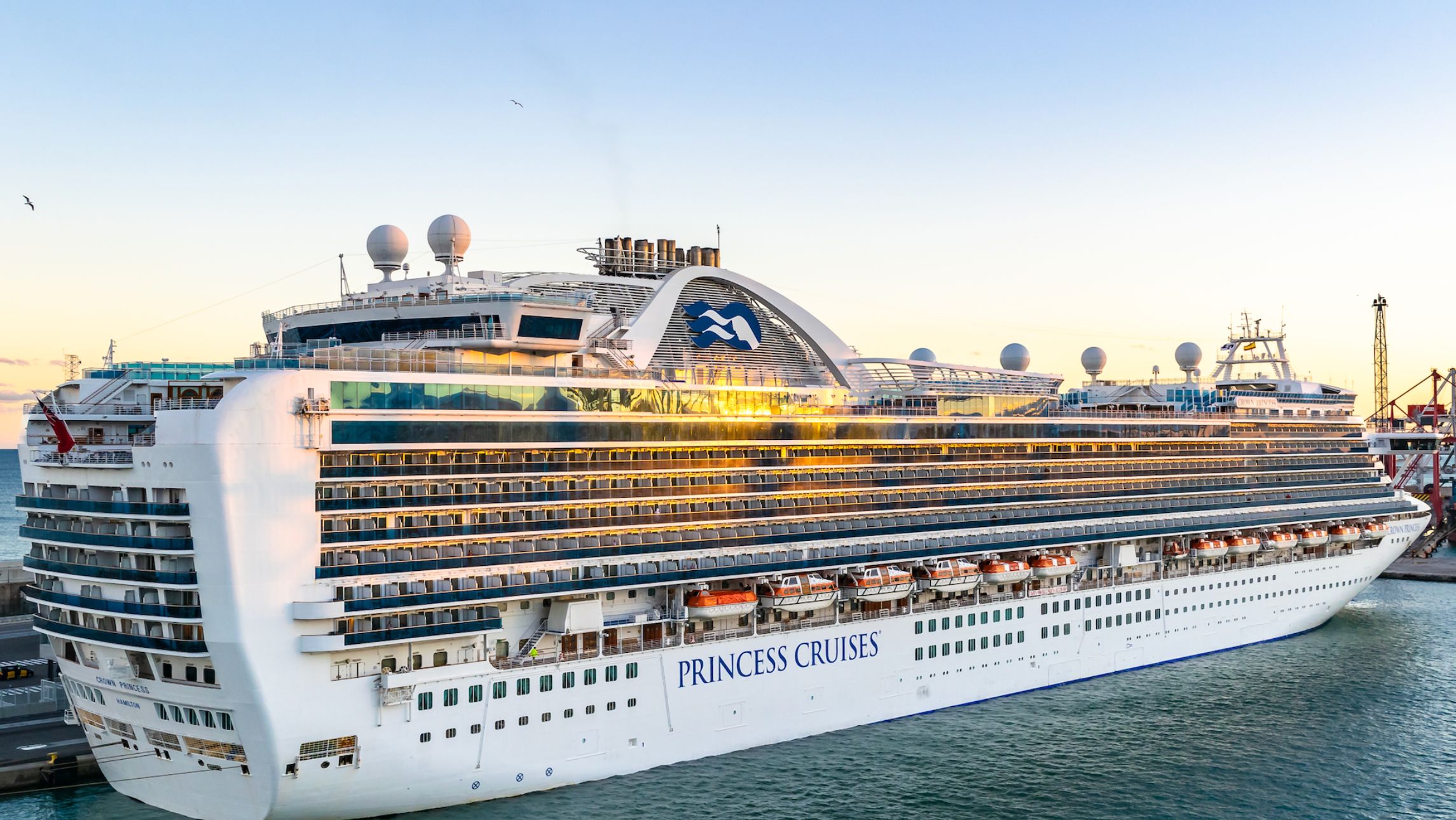A Japanese infectious disease specialist has questioned how the Japanese government handled the quarantine on board the Diamond Princess, saying it was “completely inadequate in terms of infection control” and “completely chaotic”.
Professor Kentaro Iwata a specialist of infectious diseases of Kobe University Hospital posted a video on Tuesday, describing what he saw during the hours he was allowed on board the ship where scores of Australians were kept in confinement.
There was no distinction between infection-free “green zones” and potentially contaminated “red zones”, Iwata said.
He also observed that people were walking around between the zones with and without personal protection equipment, eating lunch and handling smartphones with their protective gloves on.
The lack of zone separation extended to the ship’s medical centre and even to the medical officer. “She was saying that she was already infected so she was completely giving up protecting herself.”
https://www.youtube.com/watch?v=FNM5Af3Gfqg&feature=youtu.be&fbclid=IwAR2sm7dqquc_FIWXvUsJB7UxWhMd-s4mIk3Qoam_Gr9dA3o0L5gTVO72TsQ
It has been one of the mysteries of the sudden rise of the coronavirus outbreak: how did the largest concentration of this disease outside of China suddenly appear on a Princess ship in Japan?
Was it on board? Or did the Japanese health authorities, worried about this year’s Olympics, focus on containing the virus to the ship without paying attention to the quarantine ON the ship.
Professor Iwata said in his video that he has 20 years of experience in dealing with infections, from the Ebola outbreak in Africa, cholera outbreaks, and even SARS back in 2003. But while on board the Diamond Princess, he experienced the fear of potential infection for the first time.
“I never had fear of getting infected myself because I know how to protect myself, protect others and how infection control should be… But inside Diamond Princess I was scared of getting COVID-19 because there was no way to tell where the virus is,” said Professor Iwata.
“There was no single professional infection control person inside the ship and there was nobody in charge of infection prevention as a professional. Only the bureaucrats were doing the jobs… violating all the infection control principles and risking further infections for the people on board,” Professor Iwata claimed.
Cruise Passenger asked Princess to comment on the Professor’s claims. Their president Jan Swartz was present in Japan this week.
We were given a statement which pointed out the ship was under the control of the Japanese health authorities from the moment it tied up.
“The Japan Ministry of Health has been the lead government authority on public health defining and executing the testing and quarantine protocols for all guests and crew on Diamond Princess. In a quarantine situation, our ships, officers and crew are legally obligated and required to follow the country’s public health and medical protocols, procedures, requirements and instructions without variance. There is no flexibility allowed given the critical nature of the situation involving an infectious disease. Upon entering Japanese waters and arriving at the port in Yokohama, we immediately fell under the jurisdiction of the Japan Ministry of Health, operating under their jurisdiction for the entire duration of the quarantine.
“Our focus has been and remains the safety, health and well-being of our guests and crew, while following the Ministry of Health’s prescribed procedures and protocols.”
A few days after Professor Iwata made his comments, another mystery. He took the video down from his YouTube account on Thursday, though copies of it continued to be shared online. The Japanese and English versions of the original videos garnered over 1.5 million and 300,000 views, respectively.
Professor Iwata explained his actions on his Twitter account: “I removed my YouTube clip myself since there is no need for further discussing this. Thank you and I apologise to those who got involved in.”
I removed my YouTube clip myself since there is no need for further discussing this. Thank you and I apologize to those who got involved in.
— 岩田健太郎 K Iwata (@georgebest1969) February 19, 2020
He later told a news conference he took down the video because he was informed conditions on the ship had improved, reported The Sydney Morning Herald.
Hours later, he retweeted a photo showing how the ‘red’ and ‘green’ zones on board the ship were indistinguishable, marking out adjacent doors leading to the same space and marked ‘clean’ and ‘potentially infectious’ in Japanese characters only. The photo was originally tweeted by Gaku Hashimoto, vice minister of health, but this has also since been taken down.

Other experts also raise questions
Iwate Medical University professor Shigeru Sakurai, who led an expert team from the Japanese Society for Infection Prevention and Control on a two-day inspection on the ship Diamond Princess last week also spotted lapses in infection control measures.
He said in an NHK interview that crew members were wearing high-filtration face masks, but some of them loosened their masks after about 15 minutes because of breathing difficulty. He added that they may have touched their faces and gotten infected with the virus
He also pointed out problems with how the crew disinfected their hands. He said crew members followed the ship’s manual by washing their hands with water and disinfecting them with alcohol, but their hands could not be disinfected thoroughly if they were wet.
However, he maintains that keeping passengers on the ship was the correct decision.
“We do not have any facility suitable to quarantine such a large number of people on land,” said Professor Sakurai.
The American Centers for Disease Control and Prevention (CDC) also announced on Tuesday this week that it was imposing travel restrictions on passengers and crew leaving the Diamond Princess as it questioned the effectiveness of the quarantine on board.
“While the quarantine potentially conferred a significant public health benefit in slowing transmission, CDC’s assessment is that it may not have been sufficient to prevent transmission among individuals on the ship. CDC believes the rate of new infections on board, especially among those without symptoms, represents an ongoing risk.,” the CDC said in a statement.
The United States and Australia have both placed travel restrictions on passengers leaving the Diamond Princess, preventing entry for 14-days after they disembark.
Australian passengers who have been evacuated are also made to go through a second two-week quarantine in Howard Springs, Darwin.
“Given that there has been recent cases, we cannot be absolutely sure that any of the currently well people on the ship who are coming home on Wednesday are not carrying the virus. We can’t be sure. And if we can’t be sure, we have to take precautions,” said Australian Chief Medical Officer, Professor Brendan Murphy.
Other experts question the decision to carry out the quarantine on board the Diamond Princess.
Quarantining a ship “is a 19th century strategy”, says Hitoshi Oshitani, a virologist and public health specialist at Tohoku University, the Science Mag reported.
It might have been better to house the Diamond Princess passengers and crew on land nearby during the 14-day quarantine period, Simon Clarke, a microbiologist at the University of Reading, said in a statement today.
But finding accommodations for 3700 people for 2 weeks, plus medical staff to look after them, “would have presented a significant obstacle,” he said. Moreover, if the virus spread to the local population, “that would have caused serious logistical and political problems for local health authorities.”
Japanese authorities defend their actions
The authorities say that all infection protection measures on board the ship were conducted after consultation with infection control experts from university hospital and other institutions.
“In terms of infection management including the appropriate implementation of the zoning within the cruise ship, the doctors of the infection management support team conducted consultation and made rounds everyday within the ship, and measures were taken on the same day as when the doctors pointed out the need for improvement,” the Ministry of Health Labour and Welfare said in a report.









probably , most infection spread through the air conditioning on board , being locked up and all breathing recycled germs was a recipe for disaster, what about the genius who decided to let thousands of passengers off that ship, now four days later people in Australia and others are testing positive for coronavirus, what a surprise that must be .
From what information has been recently published, it appears if the primary issue was that while guests were quarantined, effectively the crew were not. The crew still lived together, ate together, etc., and still had contact (albeit indirect) with guests via activities like food delivery service, etc.
So the virus probably spread primarily amongst the crew, and some vulnerable guests may have picked it up through contact with surfaces that had been previously been touched by infectious crew. It’s hard to tell because they’ve not released stats on how many crew vs guests were infected.
It would be very intetesting to see a breakdown of confirmed cases on the Diamond. As in, number of passengers, number of officers and number of non officer crew.